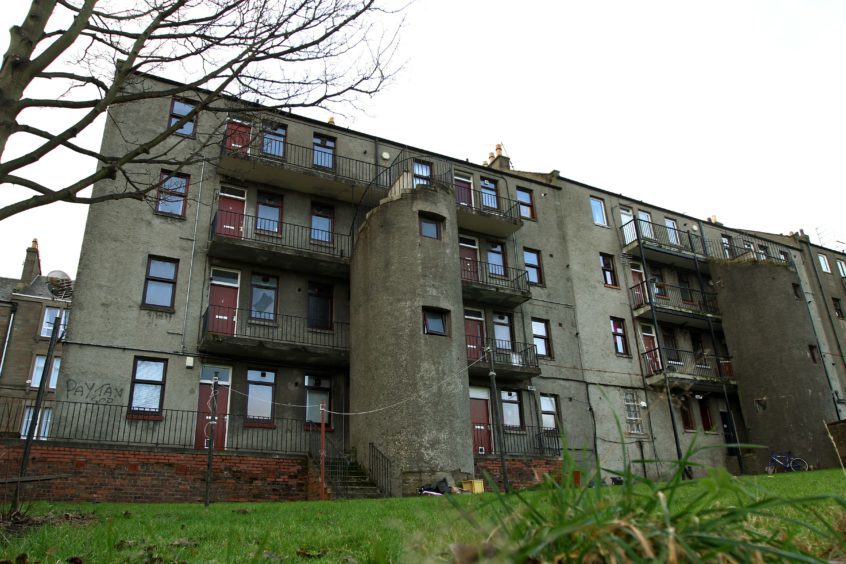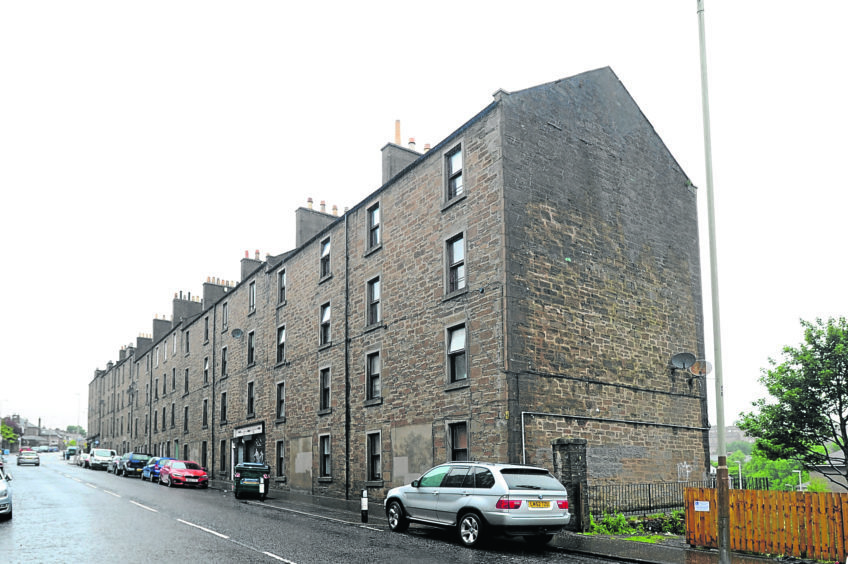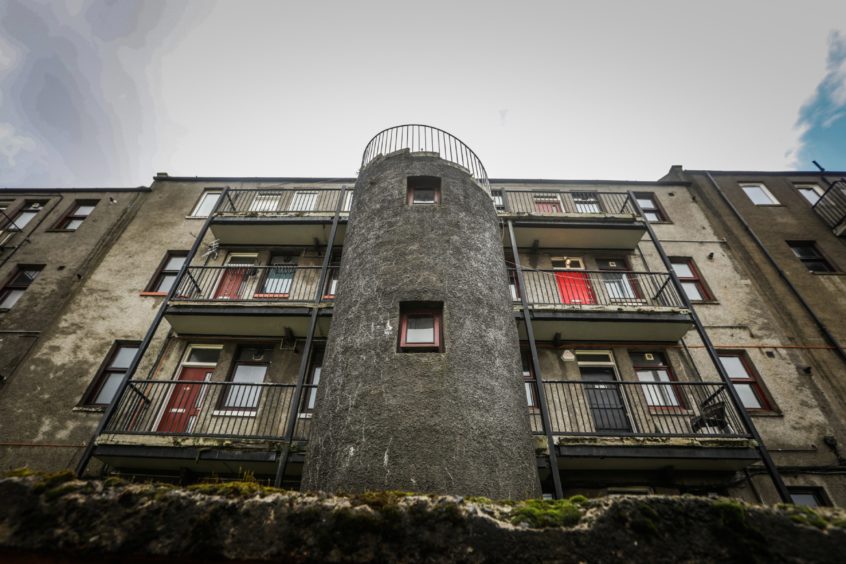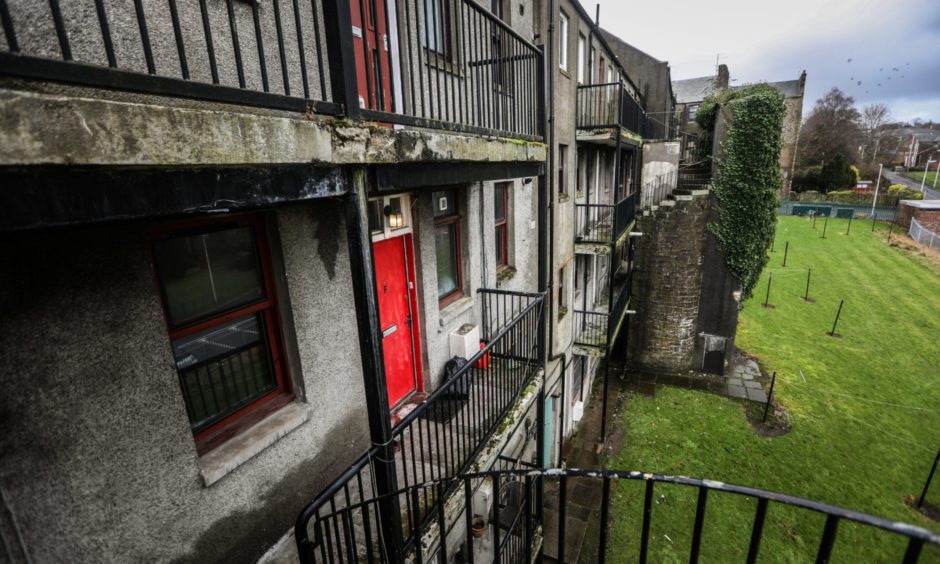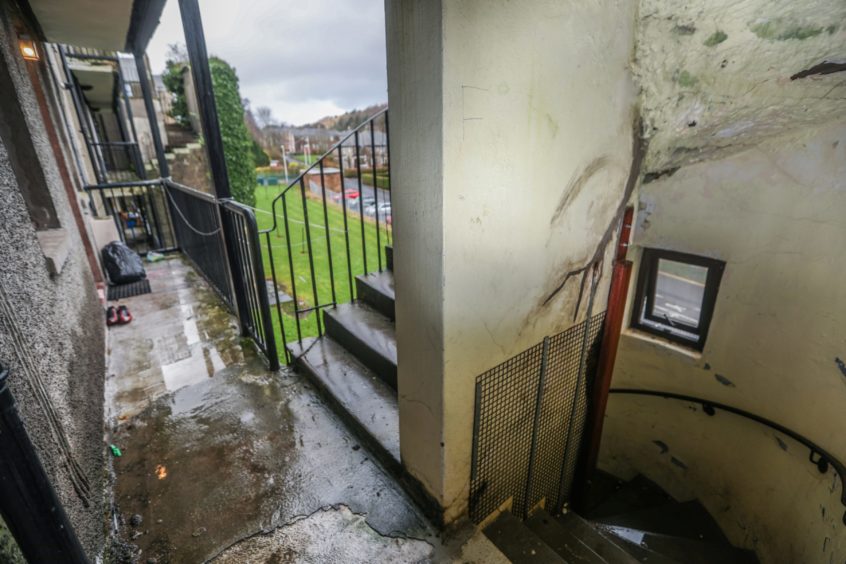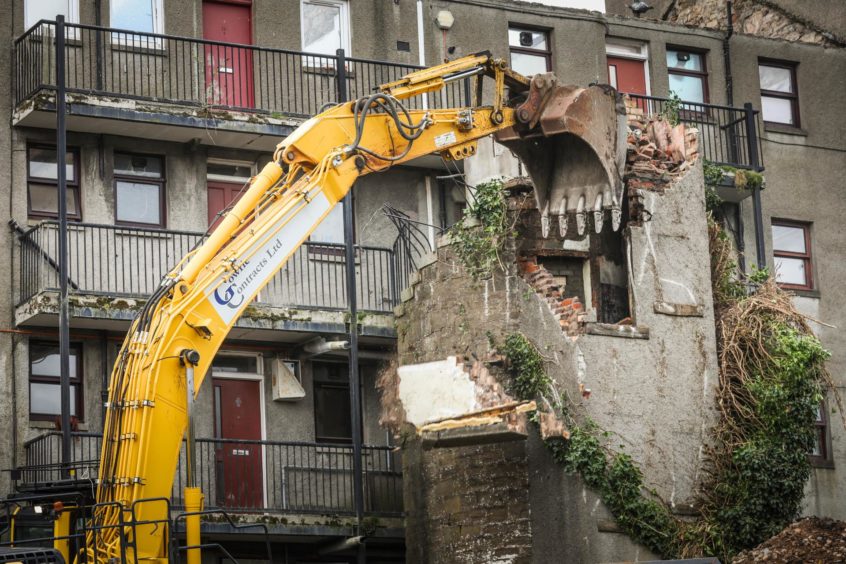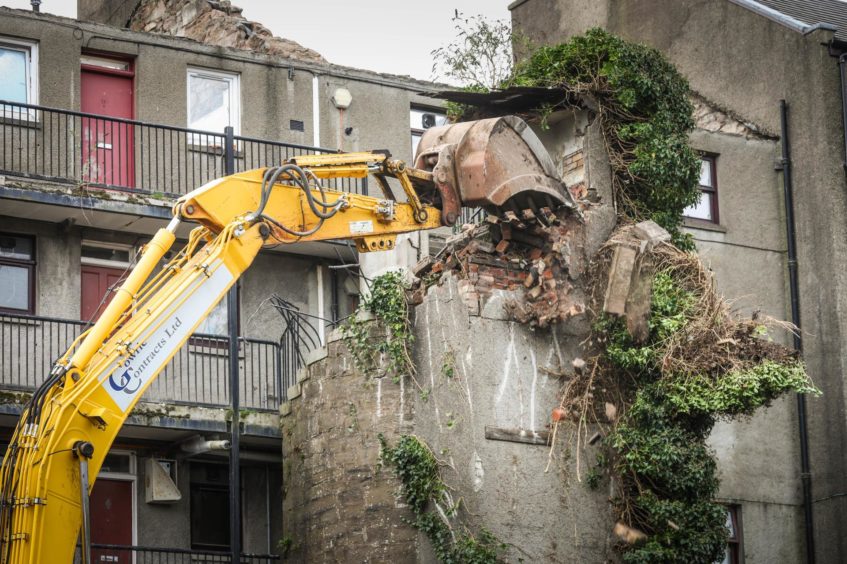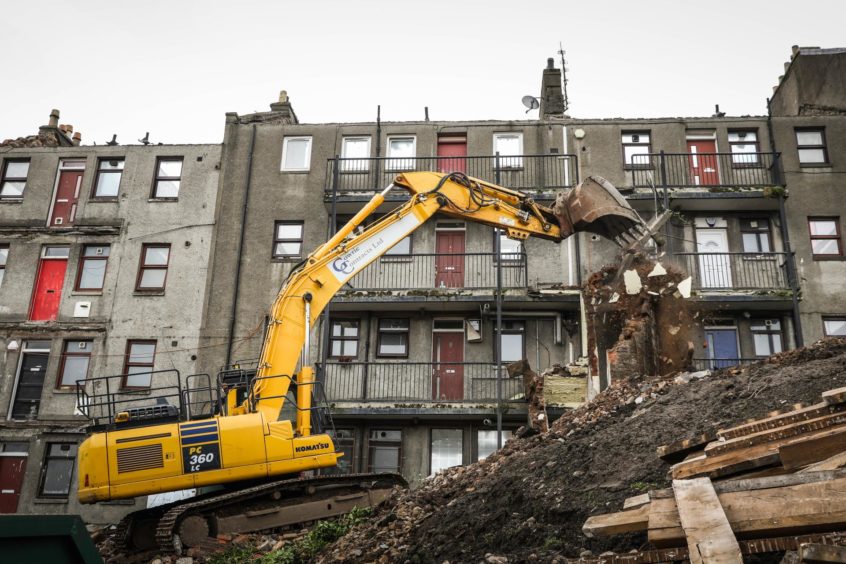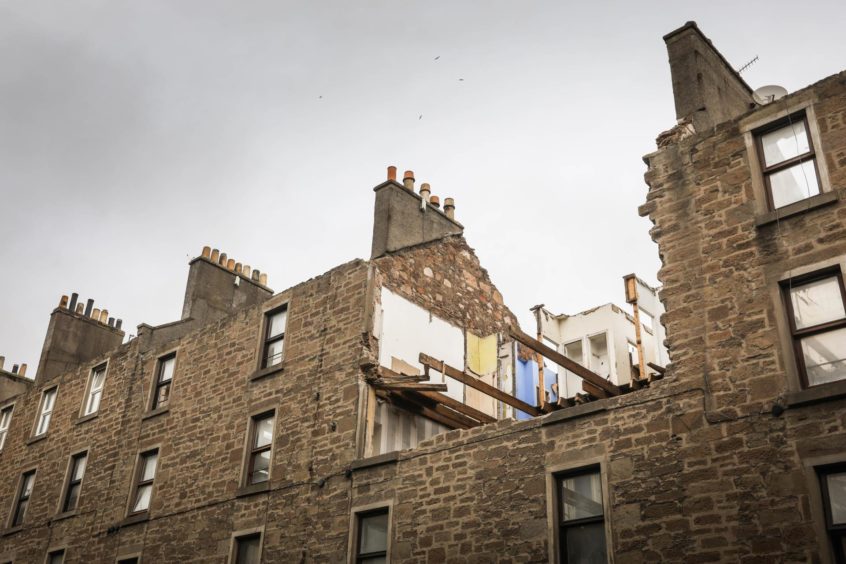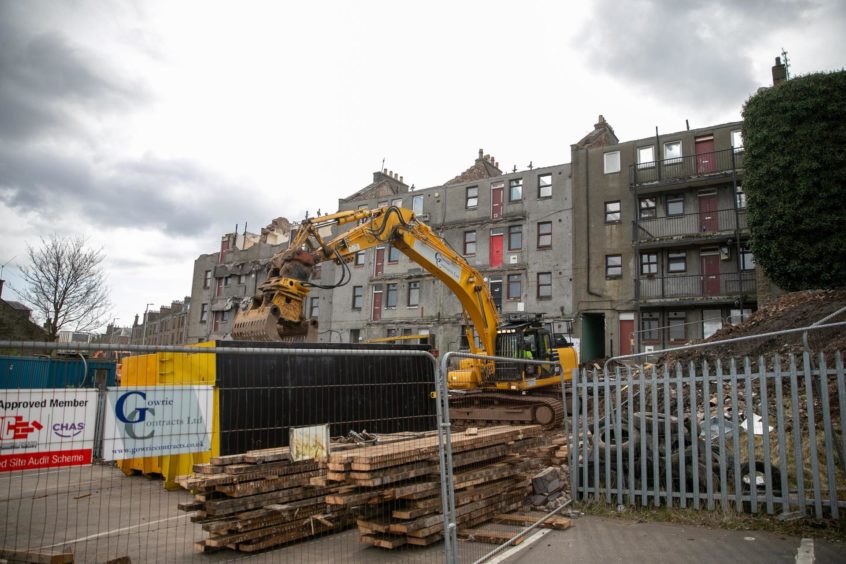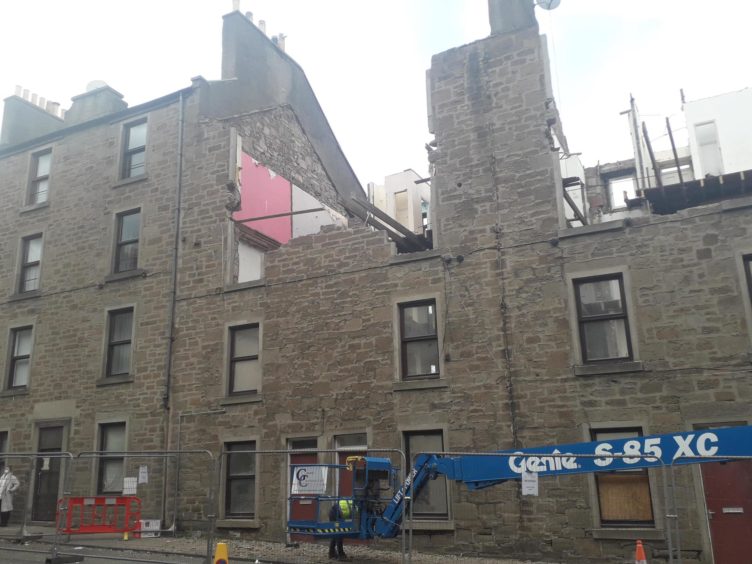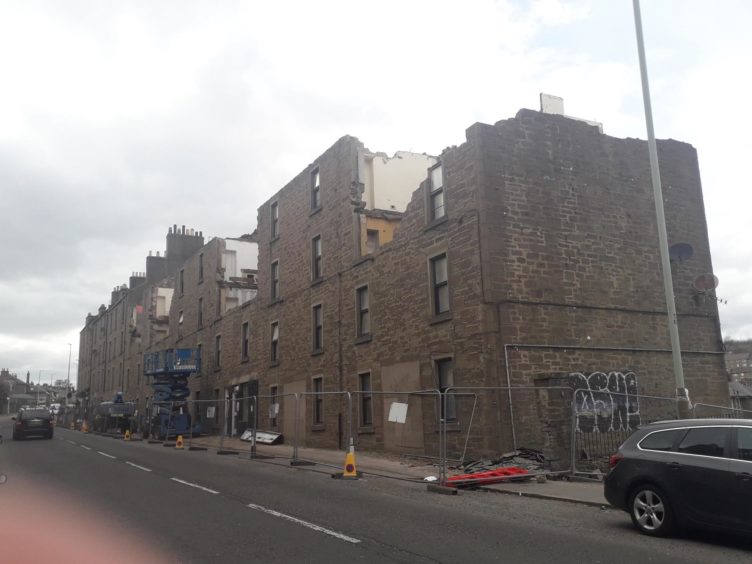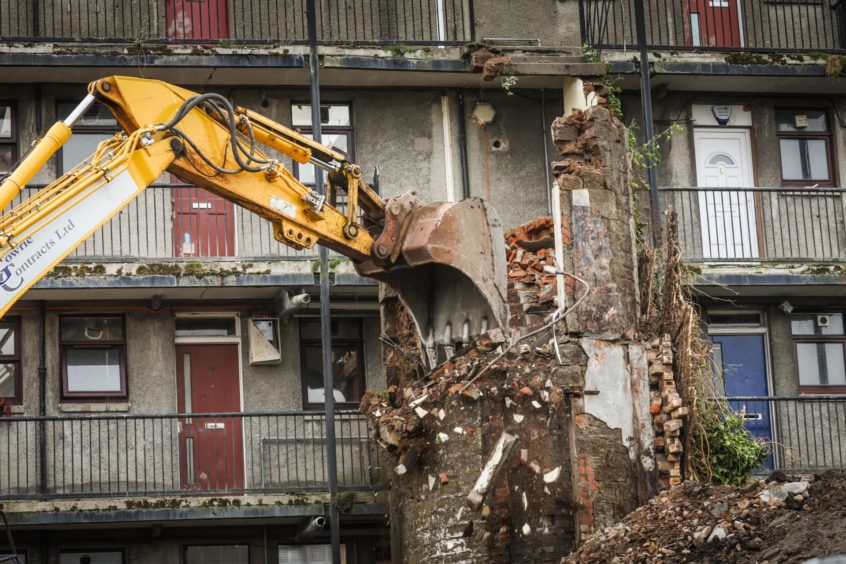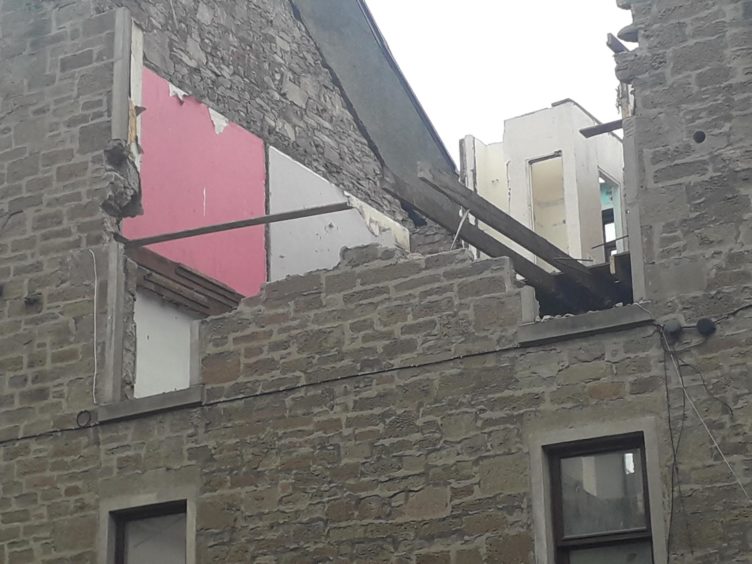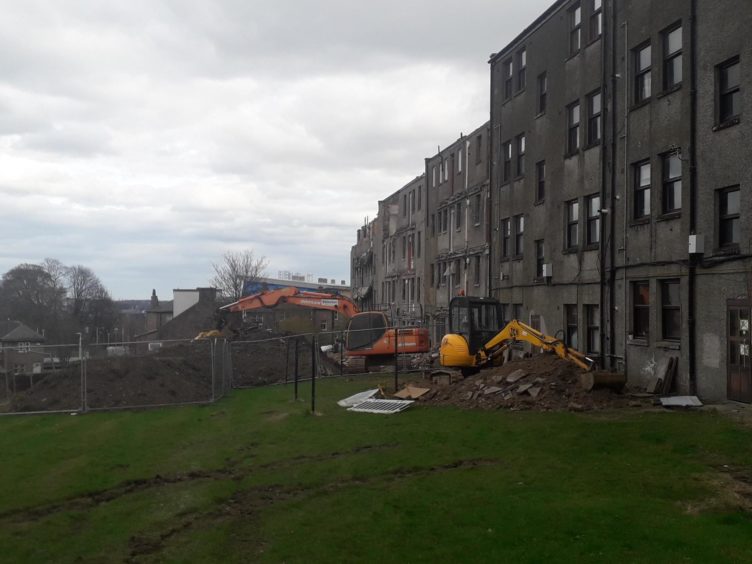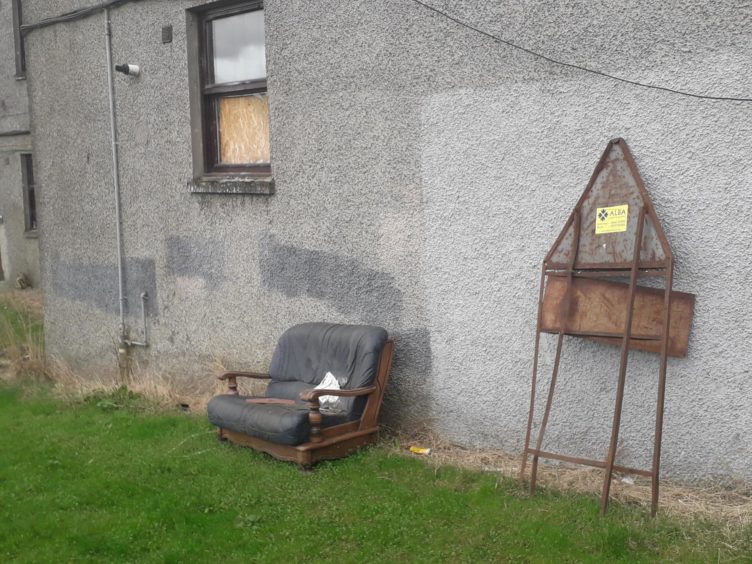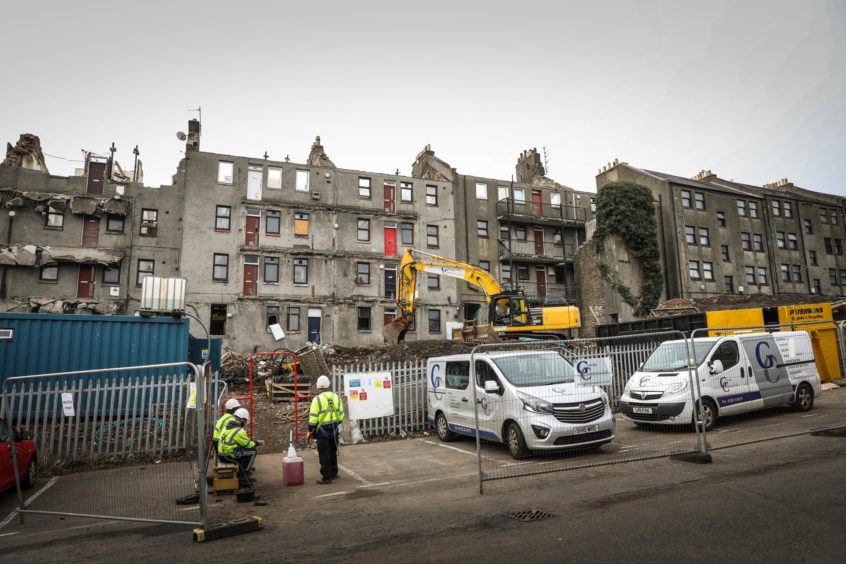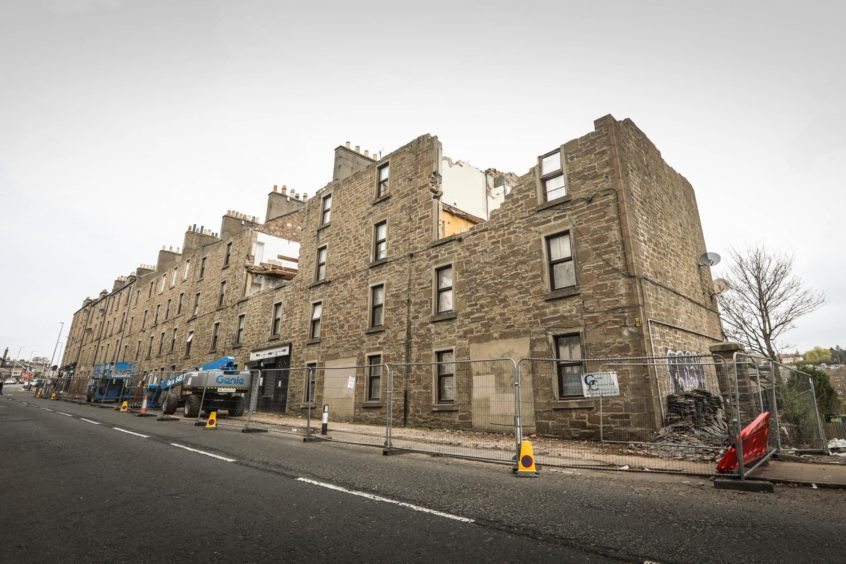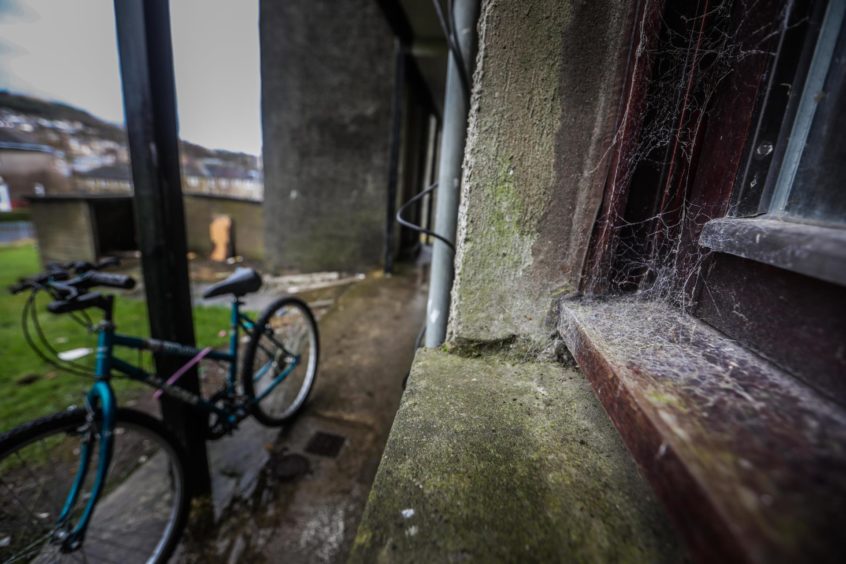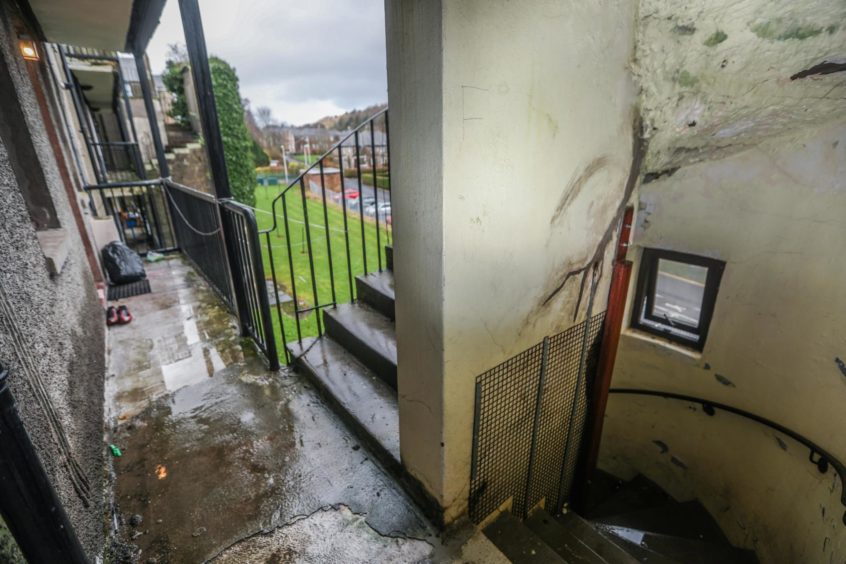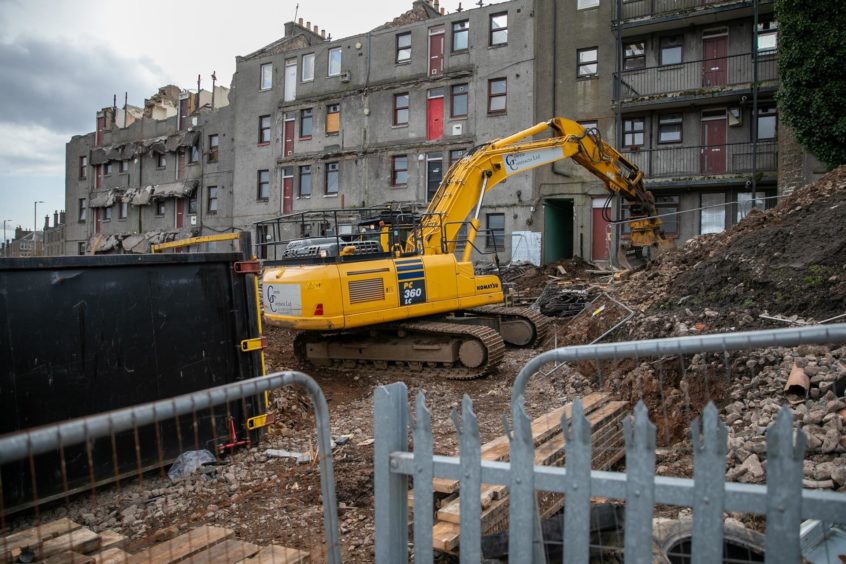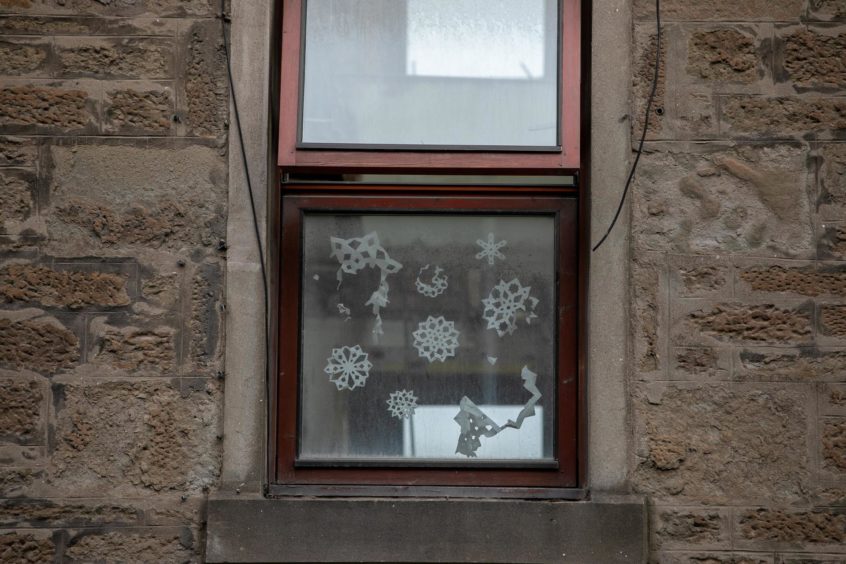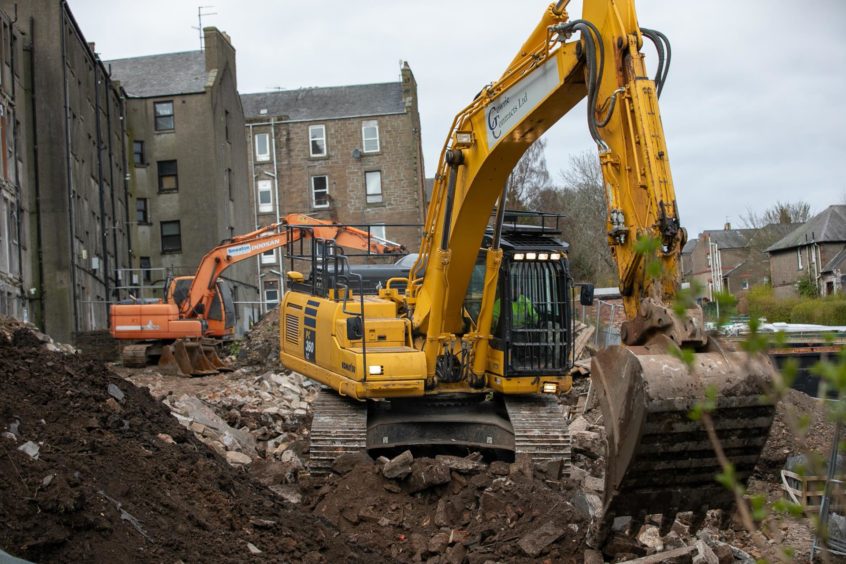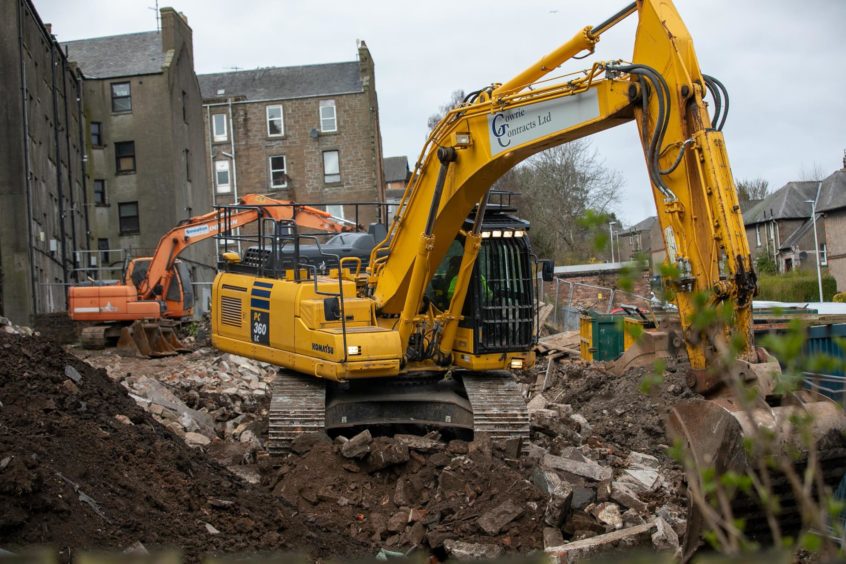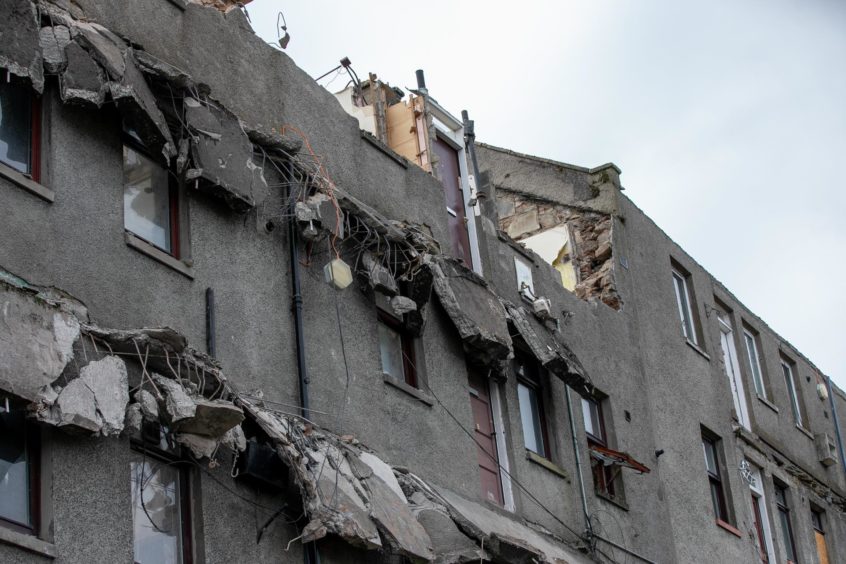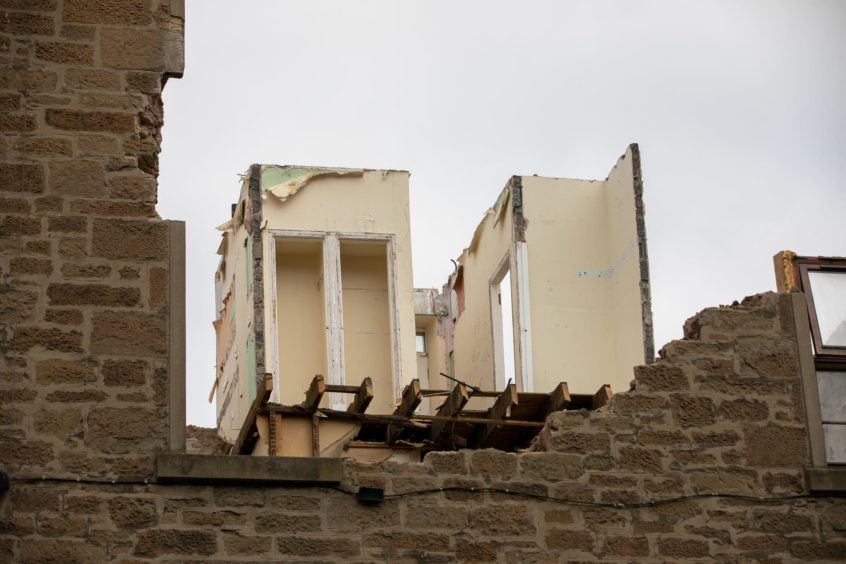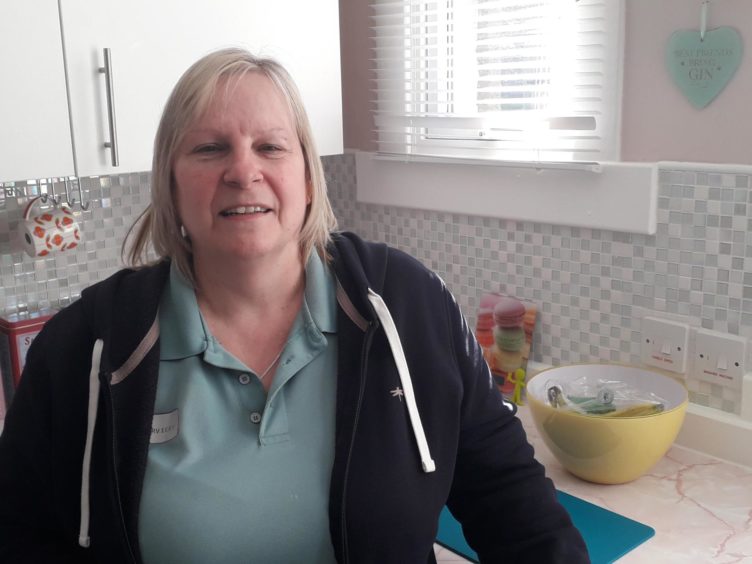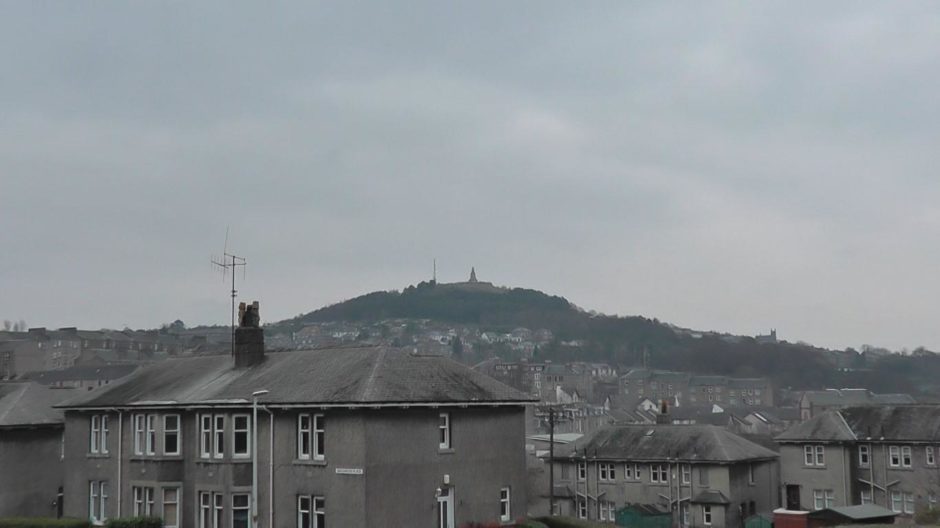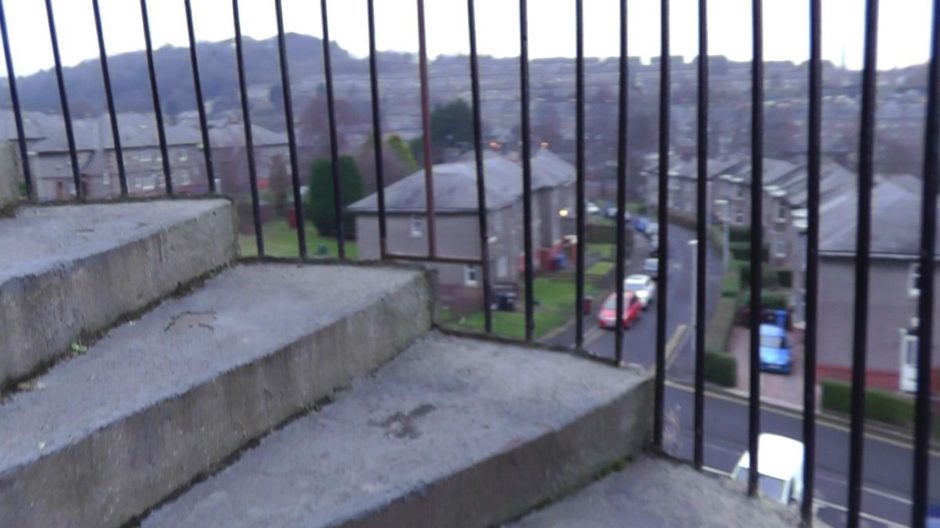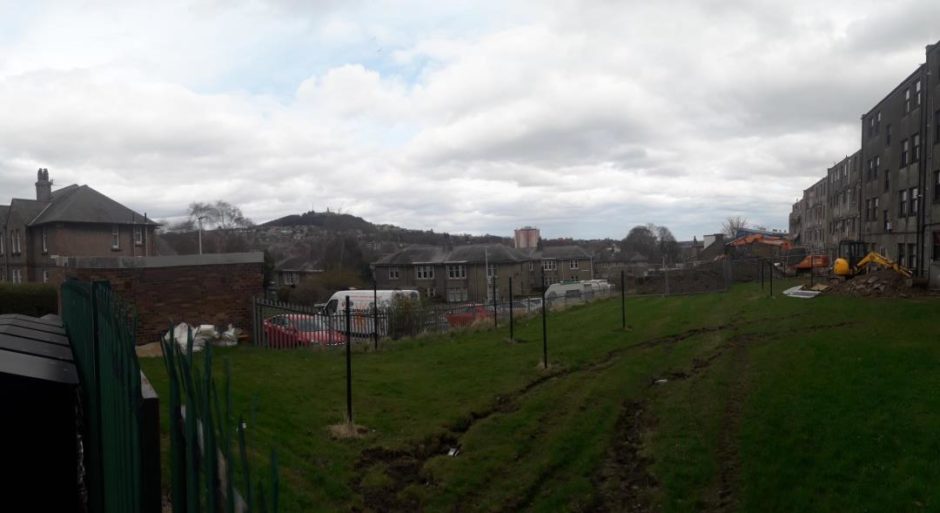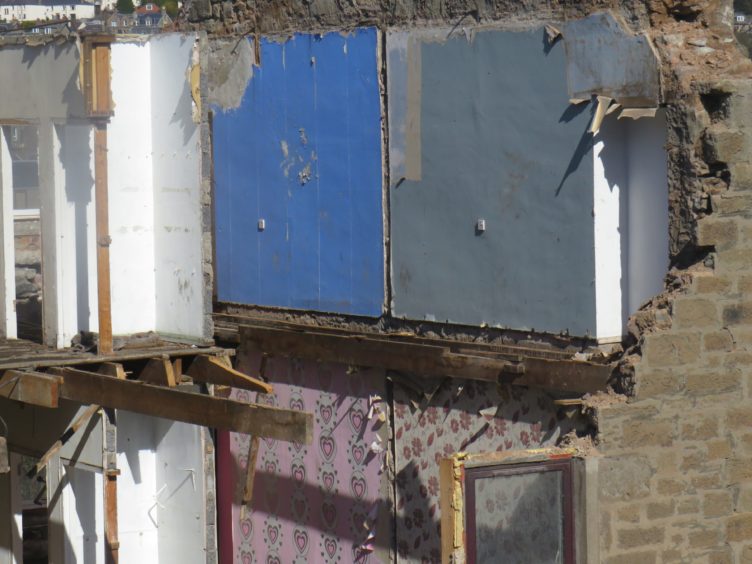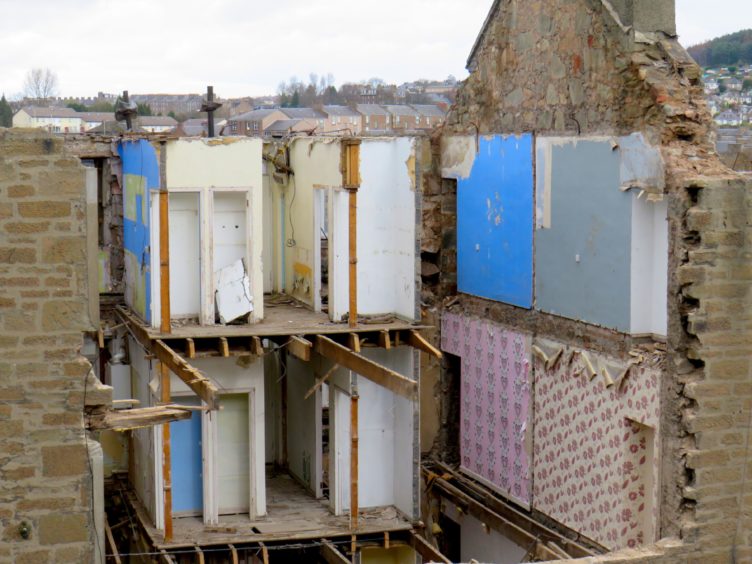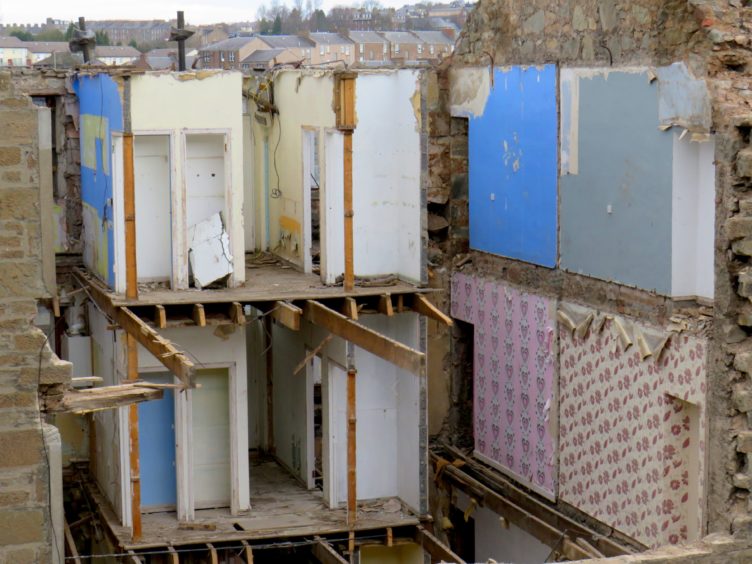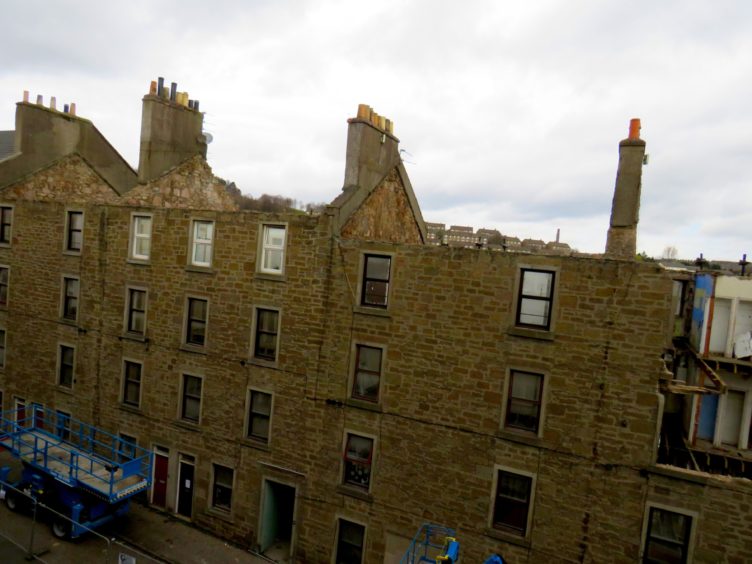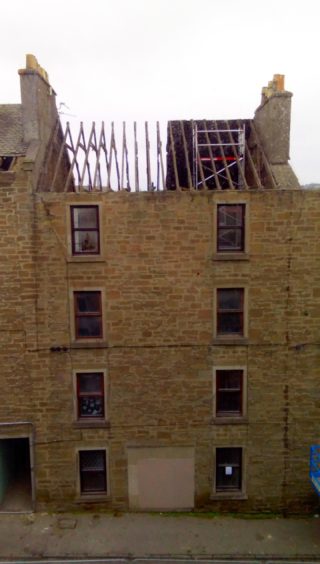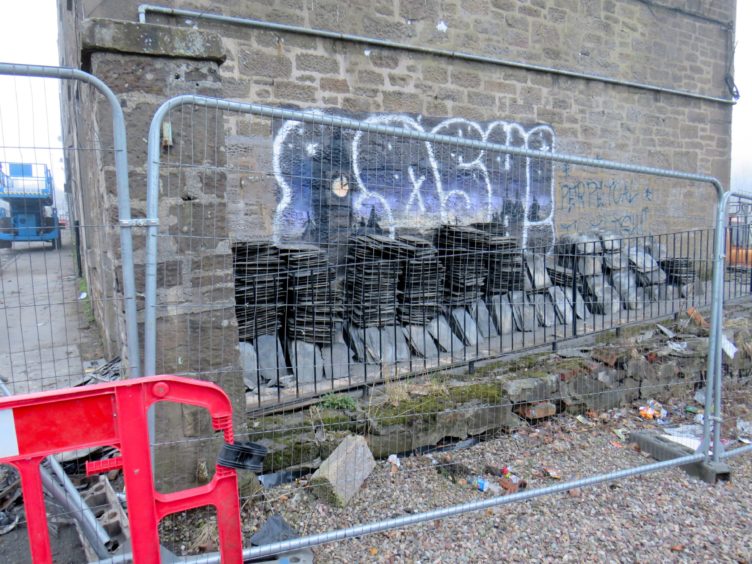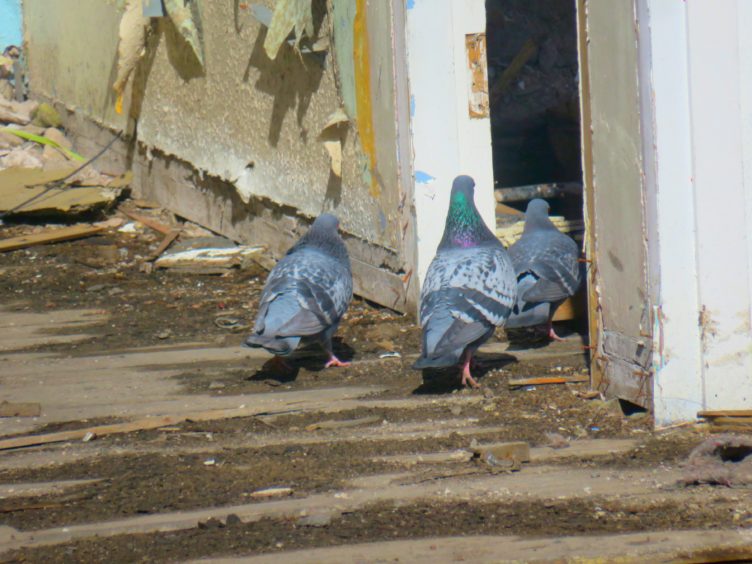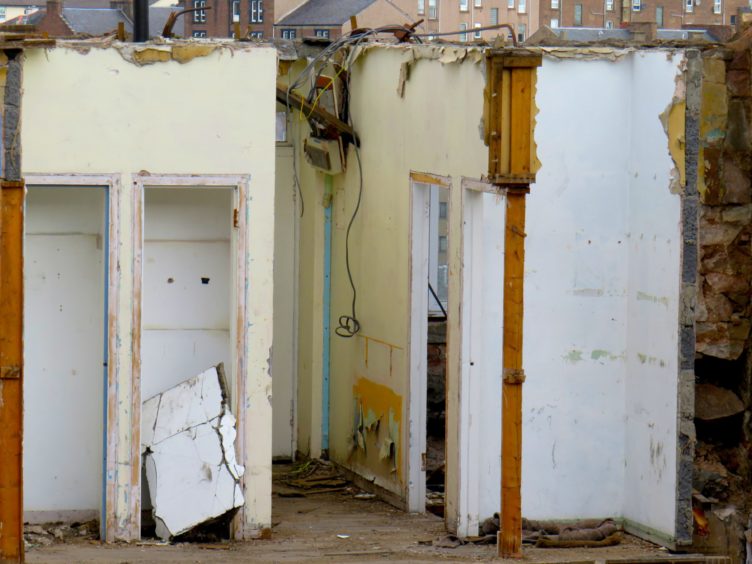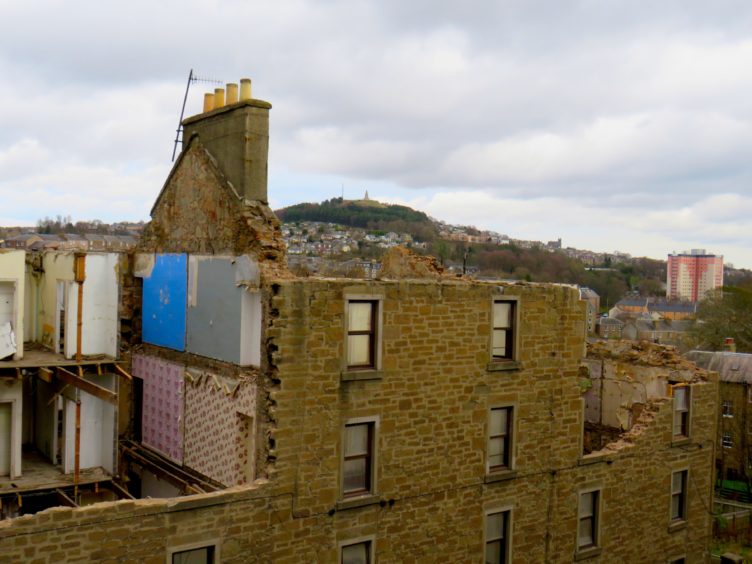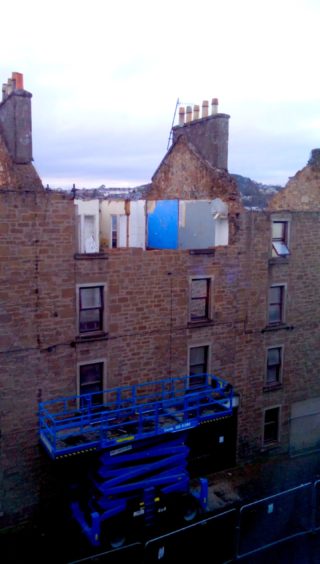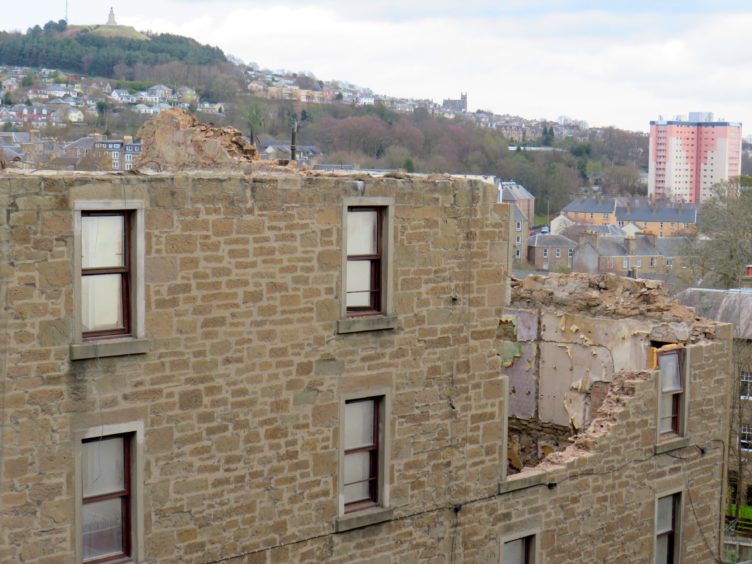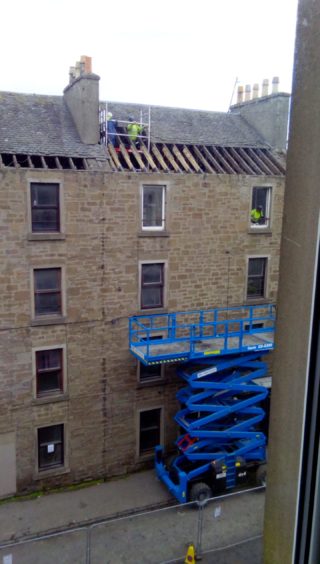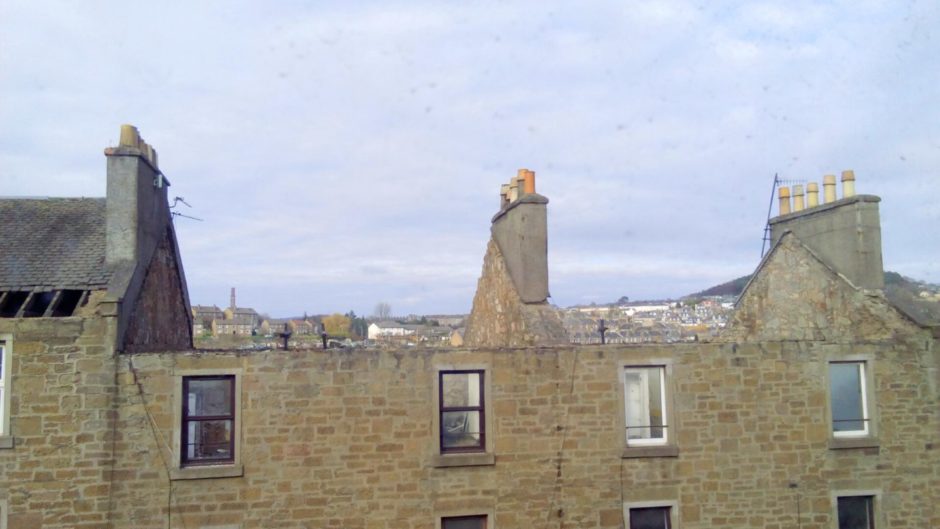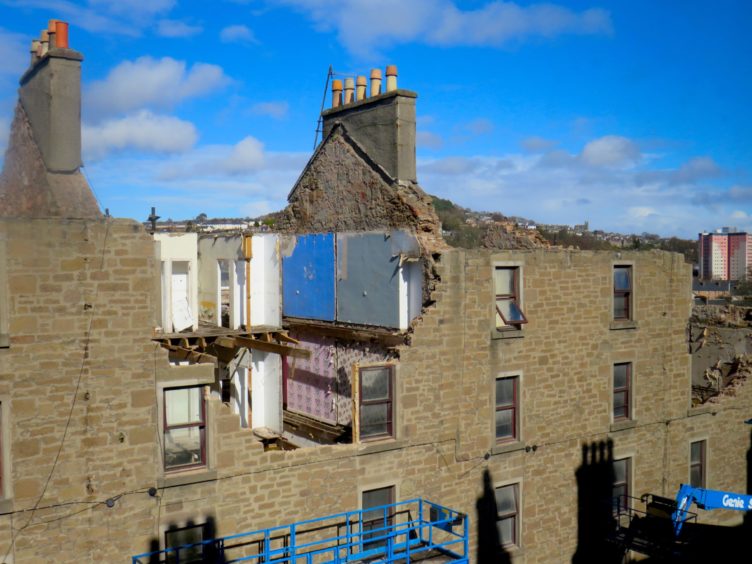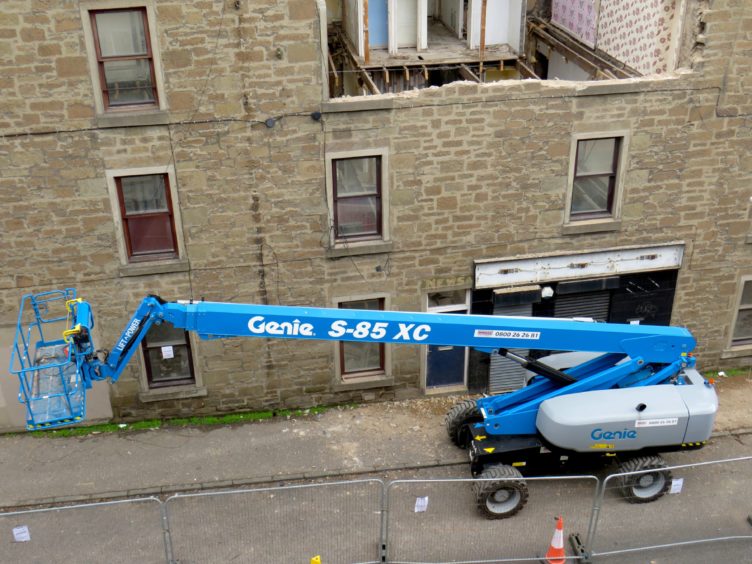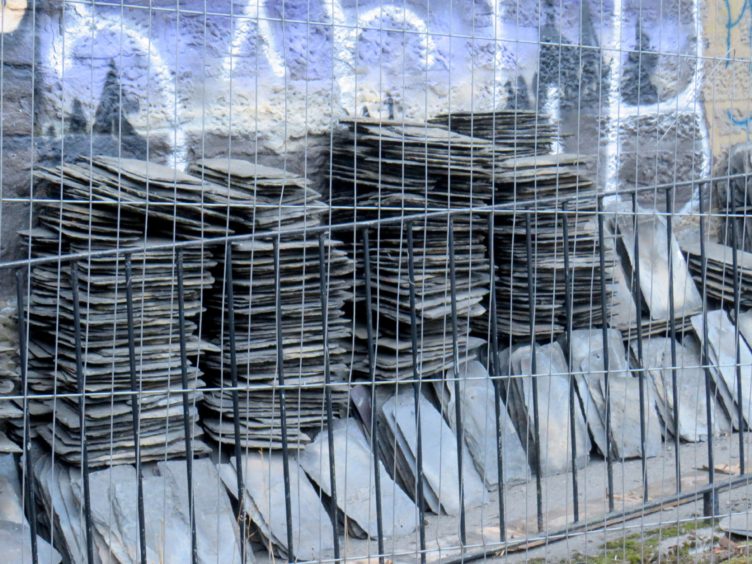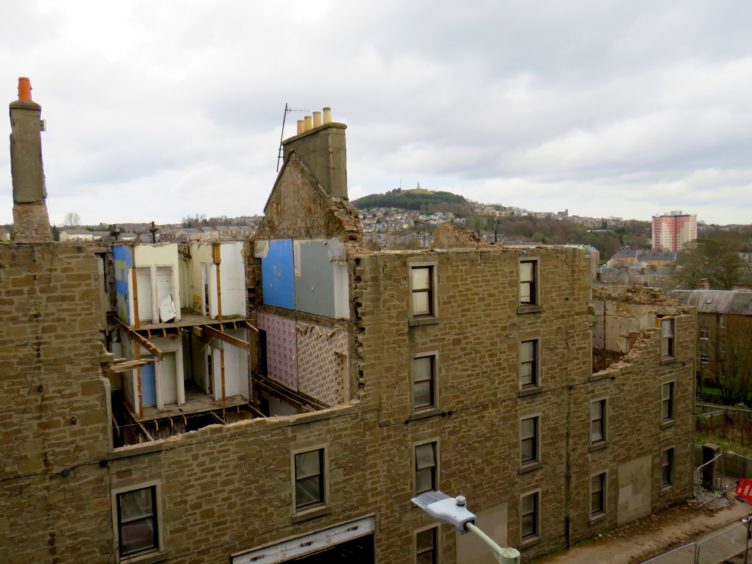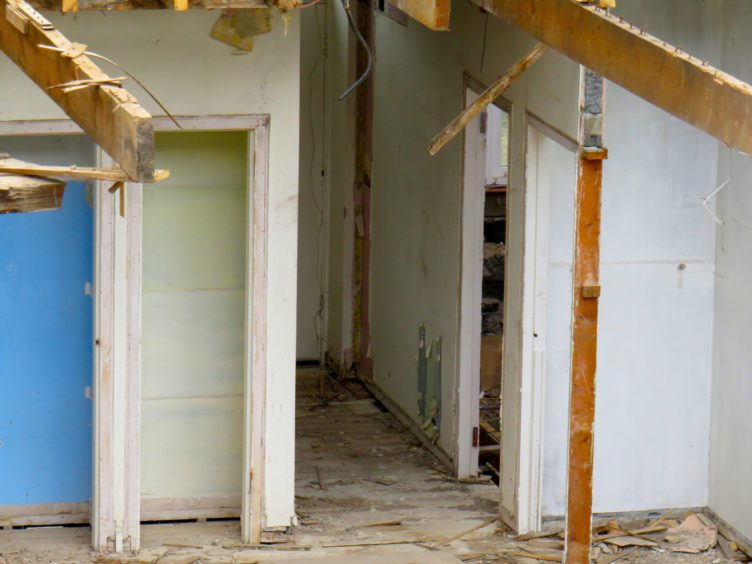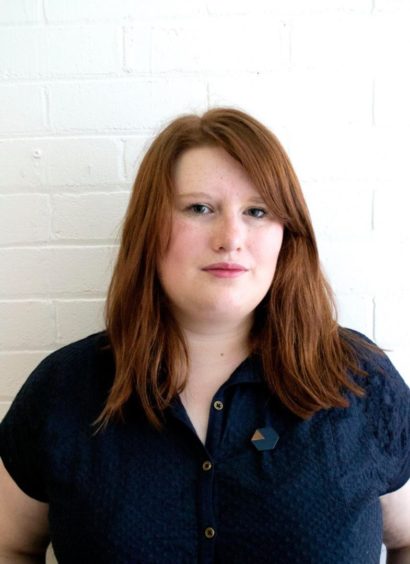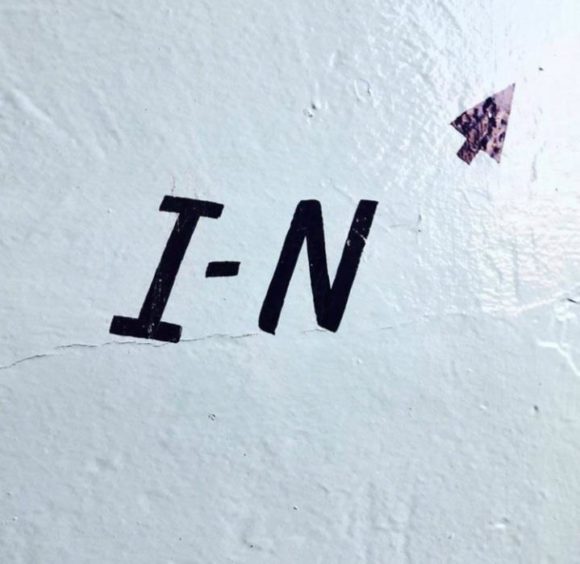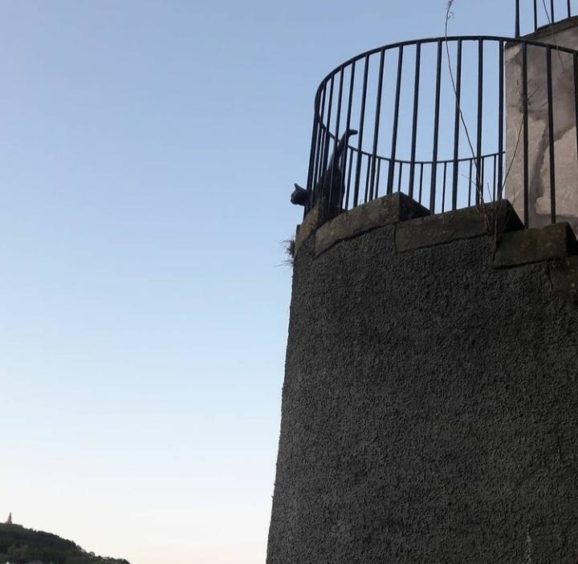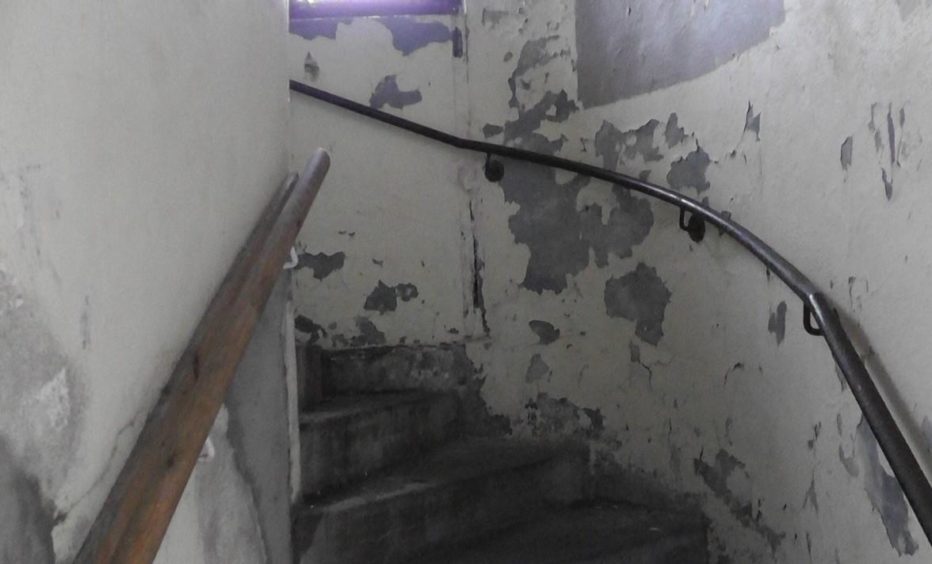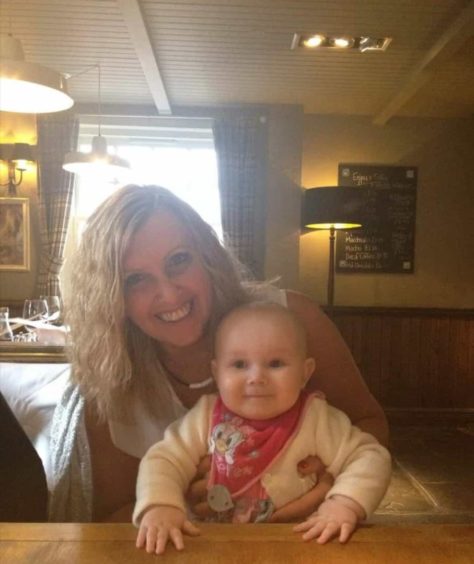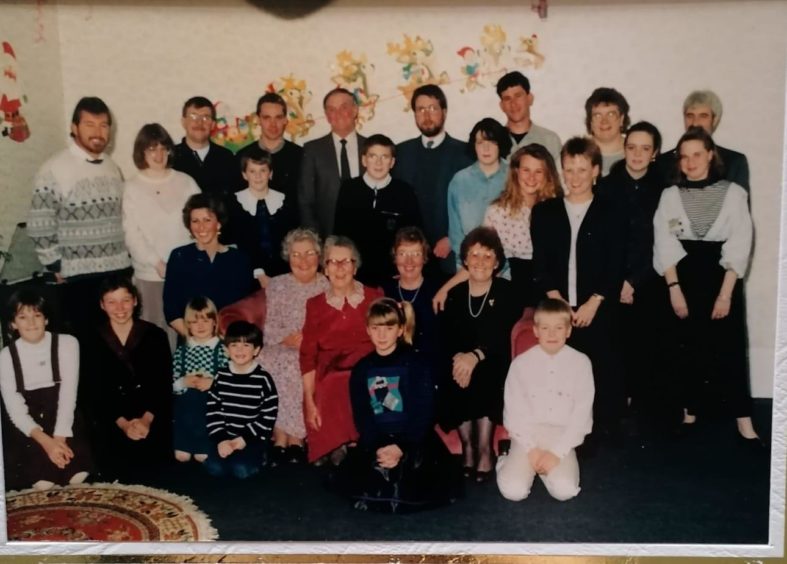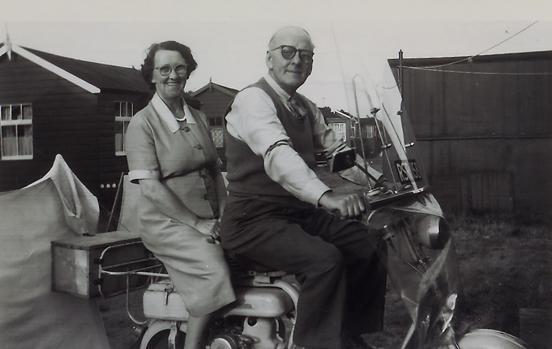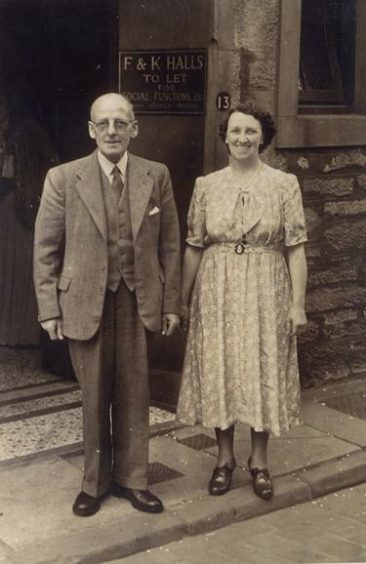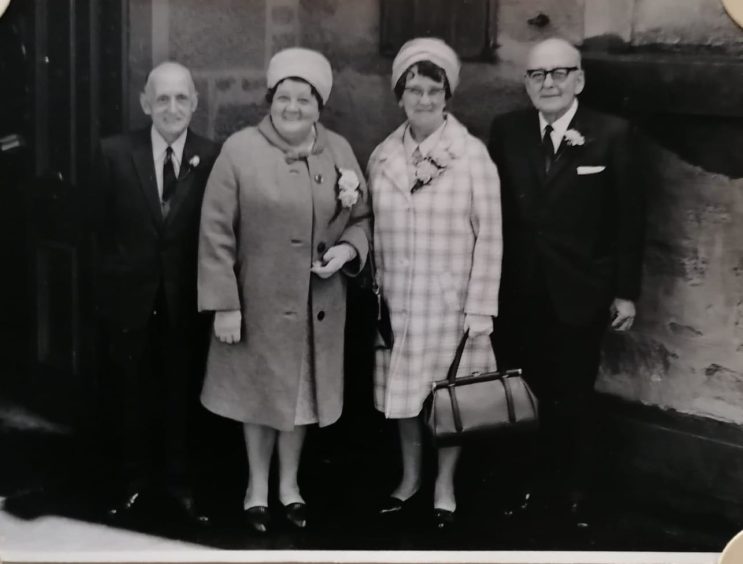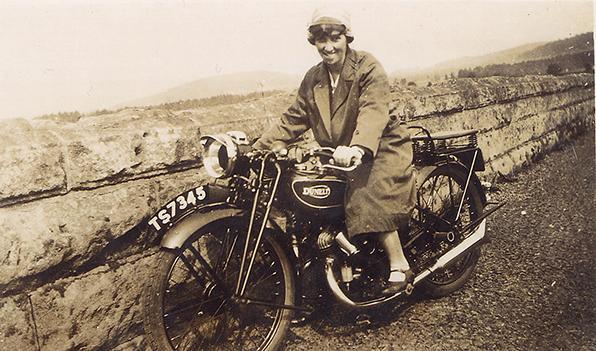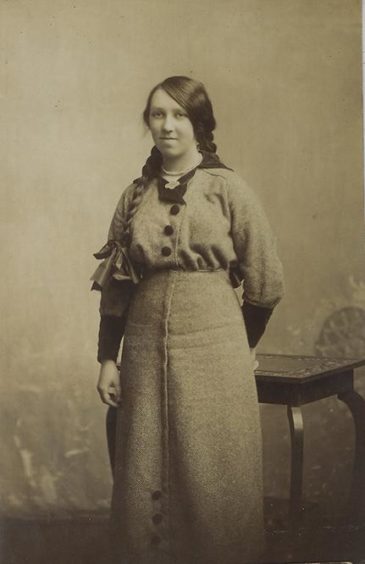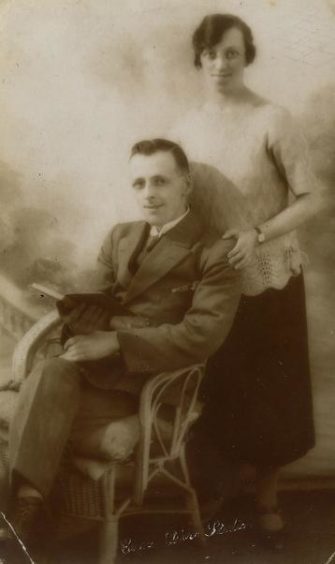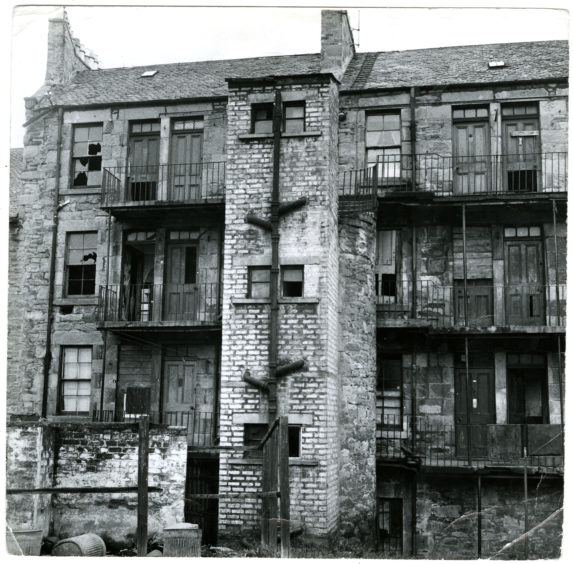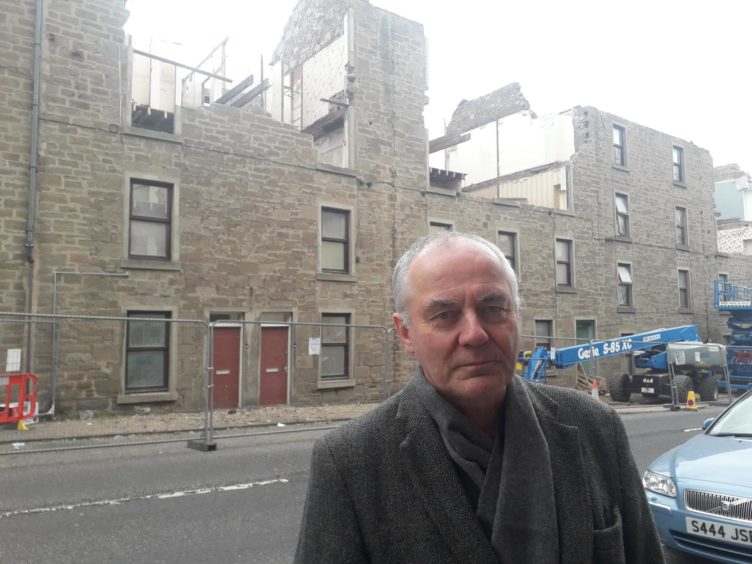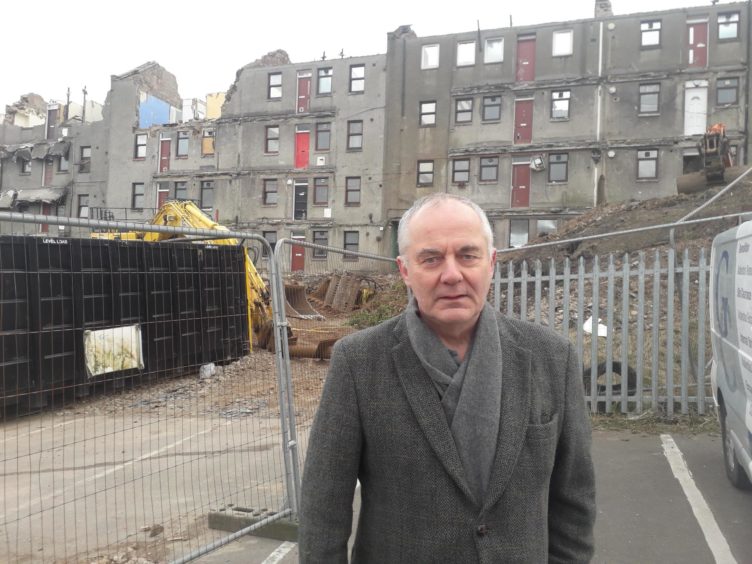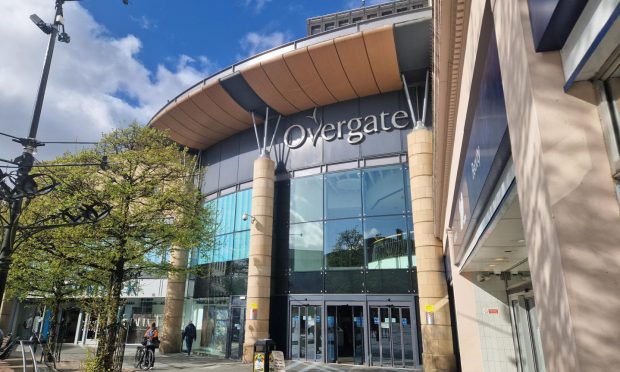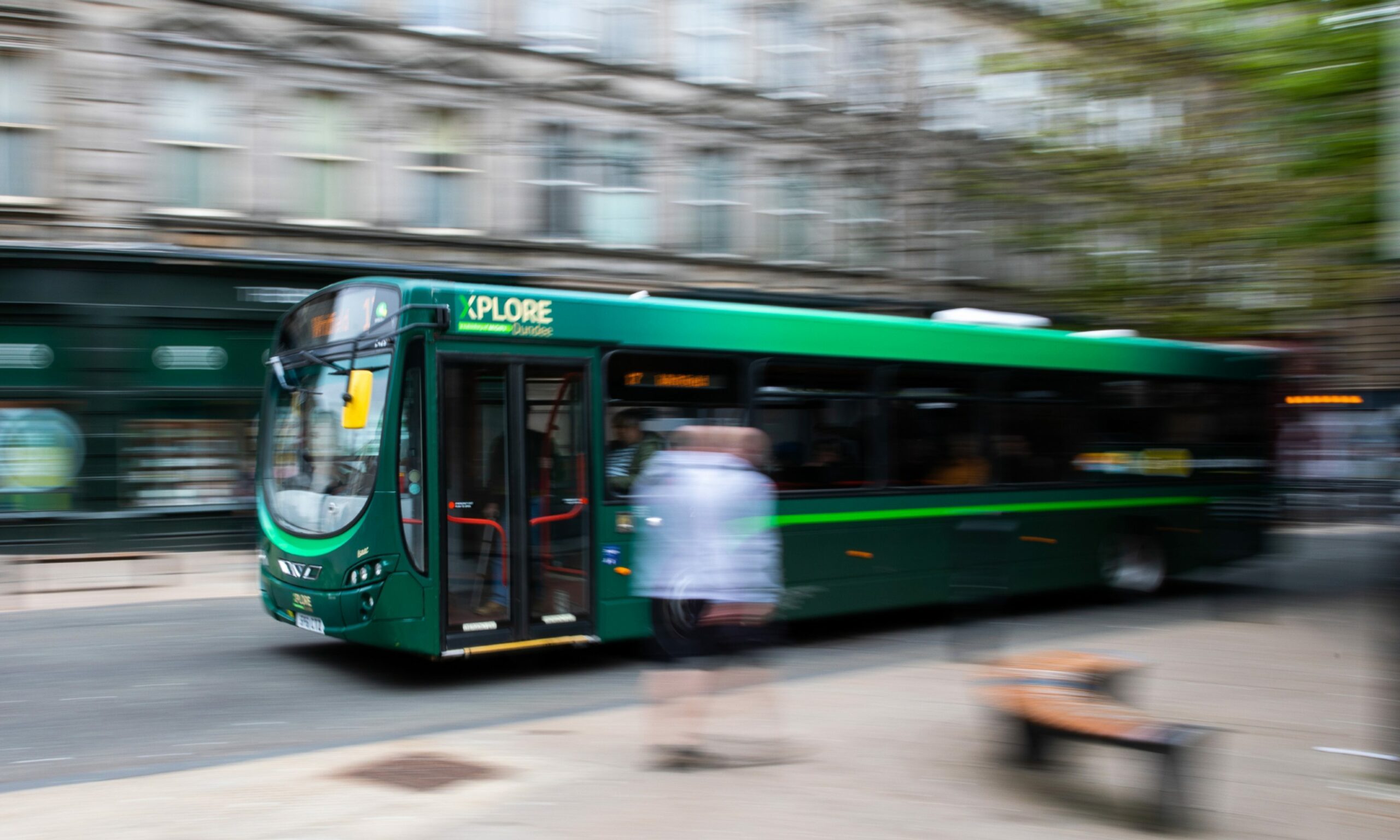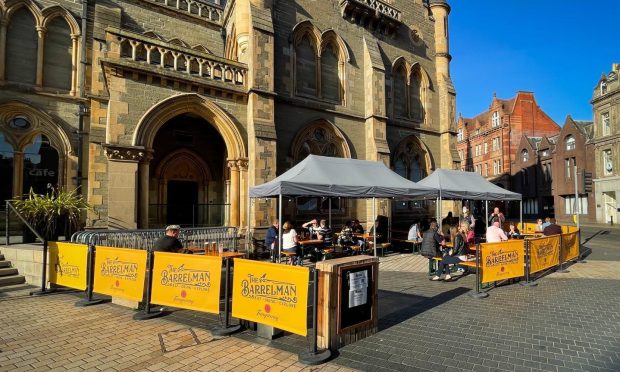If home is where the heart is, don’t expect that heart to be unaffected when the home is taken away.
Those who lived at 219-245 Blackness Road, in Dundee’s West End, know all about this as they witness the building’s demolition.
Three blocks of tenements that once stood for a mixture of safety, security, relaxation, escape, frivolity, romance, stress, anxiety, happiness, sadness, stability, turmoil and much more are being erased in front of many sad pairs of eyes.
“Each time I go past the traffic lights and see the building coming down it pulls at the heart strings,” says Helen King, a former tenant of more than two years until autumn 2019.
Psychological closure might have been easier had the Victorian-era building been wiped out in one fell swoop.
But this is a slow-motion destruction that began in March and is set to continue until the summer.
Theresa Derby, the final person to leave the flats in February 2020, has been avoiding the area in recent weeks because of the pain at seeing the demise of her home of 30 years.
“I passed the flats the other day as they were being demolished and it brought a tear to my eye to see it like that,” she says.
“When it’s fully demolished it might help because once it’s gone it’s gone.”
Here we acknowledge the historic, emotional, architectural and political significance of the flats at 219-245 Blackness Road before they are gone forever.
Farewell to 130 years of history
The building at 219-245 Blackness Road was erected in the 1890s using sandstone to house the city’s rapidly expanding jute mill workforce.
The design is in a tenement style still common throughout Dundee and comprised three blocks of eight homes and a shop unit. By 2017 there were 10 sold flats, 16 council flats and the one shop.
To the rear were three external stairwells. They were thought to be the only ones remaining in Dundee.
On October 30 2017, Dundee City Council’s neighbourhood services committee decided to demolish the blocks after its engineers reported the stairwells will last no longer than five more years.
The council estimated that repairing the stairwells would have cost between £880,000 and £1.2 million.
Meanwhile, demolishing and then redeveloping the site was thought to come to £4.5 million, albeit with the possibility of grant funding.
The demolition on its own was estimated to cost £310,000 and the council predicted a spend of £800,000 on buy backs and associated payments for the 10 privately-owned flats.
Among the known prices, the highest amount paid was £120,000 for flat 237e.
‘It brought a tear to my eye’
Theresa Derby was the final resident to leave the flats and she might also be one of the last to recover from the situation’s traumatic side-effects.
This would be understandable. Theresa, 54, spent 30 years at 237g Blackness Road and fought tooth and nail both to buy her property and to stop it being demolished.
She also loved living there and when forced to leave felt she had been unfairly treated by Dundee City Council.
Theresa’s departure on February 23 2020 marked the final day of around 130 years of continuous habitation in the flats.
“I passed the flats the other day as they were being demolished and it brought a tear to my eye to see it like that,” Theresa says.
“When it’s fully demolished it might help because once it’s gone it’s gone.”
Theresa was born in Arklay Street in 1966. She was one of seven siblings.
Nine years later, following the death of her father James, she moved to a bedsit at 174 Blackness Road along with her mother Elizabeth and brother Gordon. By this time her other brothers and sisters had moved out of the family home.
As a young adult Theresa gave birth to children Nicola and Lee. Briefly she had her own place in Thomson Street, off Perth Road, before moving back in with her mother.
It was not a long-term arrangement and in 1990 one of her mother’s friends told her about a two-bedroom flat going empty at 237e Blackness Road after the previous occupant passed away.
Theresa, who works as a porter at Ninewells Hospital, contacted the council and her luck was in.
“To go from a bedsit to there felt like sheer luxury,” she says. “The kids had their own room and I already knew a lot of the neighbours from living on the same road.
“When I moved in it felt like going back in time to the 1960s. There was an old fireplace and layers of wallpaper with an old-fashioned kitchen containing a white oblong sink and wooden bunkers.
“But I couldn’t complain and the council installed a new kitchen. It was a great place to live.”
‘I knew everybody and everybody knew each other’
Theresa did all she could to make her tenement a great home for her children to grow up in, even giving up her bedroom to Nicola when she became a teenager so she could have some privacy.
“In the early days I knew a lot of people living in the flats who worked in the Balgay Hill Bar, which is where we used to go.”
“There was a beautiful view as you walked out of the door to the outside stairs. You could see Law Hill and then, if you looked to the side, Dundee Docks.
“When there were fireworks we could see them from the stairs so you wouldn’t need to go anywhere to find them.”
After her children moved out Theresa regularly looked after her granddaughter Kady, now aged 15. She was seldom lonely.
“It was a really good place to stay. I knew everybody and everybody knew each other.
“I used to babysit for the neighbours and they babysat for me.
“Over the years the tenants changed quite a bit because a lot of the homes were owned by landlords.
“But it was no bother. Once your door was closed you wouldn’t see anyone so you wouldn’t notice any trouble.”
Only resident in flats at Christmas
In the latter part of the previous decade Theresa says she tried to organise a right to buy agreement with Dundee City Council but without luck.
“I had a mortgage offer accepted but it was being delayed by the council for various reasons. I was given the run-around.
“Then we discovered from a reporter that there were plans for it to be demolished. If they’d just been honest it would have been much better.”
The decision to demolish the homes was made in October 2017. Theresa fought hard to keep the properties intact but as time went by her neighbours were being rehomed. The blocks were becoming emptier.
Theresa wanted to be transferred to a two-bedroom property in Logie and was determined to hold out.
But the offer was not forthcoming and by Christmas 2019 she was the only resident still in the flats.
“The council was not giving me what I wanted so I stayed there. Out of 26 flats there was only me left. It was like that for a good few months.
“Christmas was absolutely fine. I just imagined that there were people there but I just wasn’t seeing them.
“A couple of times there were people hanging around on the stairs but it was never any bother.
“I was determined to hold out for what I wanted so got used to it.”
Theresa’s patience paid off and she moved to Sycamore Place in Logie the following February.
“I am quite high up where I live now so again I have really nice views,” says Theresa on her current home in Logie.
“I don’t think I really appreciate it though. Maybe I will once the Blackness Road flats have been demolished.
“I have been deliberately avoiding the Blackness Road area but one day from Logie Avenue I caught a glimpse of the flats being demolished. It was so sad.
“I just hope I can enjoy this home as much as I did my previous one.”
‘I would proudly tell myself: ‘I have a plettie!”
Living at the Blackness Road tenements was a metaphorical badge of honour that Helen King was proud to wear.
Helen, 25, grew up in Edinburgh so had no idea what a “plettie” was until Dundonians remarked with awe at where she fondly called home.
“I used to say to people that I lived at Blackness Road, where the ‘stairwells’ are. People would know it well as the only flats in Dundee with external stairwells.
“People used to call them the pletties, for having balconies outside, and I thought it was nice.
“I would proudly tell myself: ‘I have a plettie!'”
Helen moved to Dundee at the age of 18 to study fine art at Duncan of Jordanstone College.
During her degree and masters courses she rented a studio flat in Seafield Road. In the summer of 2017 she needed to move out and decided to find somewhere with friend Christina Marie.
“I asked my landlord if there was somewhere suitable and he said about 237d Blackness Road,” Helen says. “We were the first people to see it.”
Helen was mightily impressed by the first-floor tenement flat.
“The flat had been freshly decorated and there was a new kitchen and bathroom. Everything had been painted with bog-standard magnolia.
“It was a cosy, homely flat. It was perfect.
“The area was nice, the street was tidy, the shared back area was tidy. Perfect, we thought. It was perfect.
“One of our favourite things was the balcony at the back and the view from it. You had Balgay Hill on one side and Dundee Law on the other. We really loved that space.
“It was such a happy time and it seems so much longer than two years that we lived there.”
Rise of drug dealers
Things began to turn sour for Helen from early 2019, when tenants started moving out without being replaced. Demolition was looming.
“Drug dealers were using either empty homes or the stairwells. We were well aware that this was happening,” says Helen, who now works as a development worker in a higher education programme.
“On a couple of occasions there was a police presence and we had the knock on the door from the police.
“That was when it got scary. I was not directly approached but the awareness that on the other side of my door there were people off their face on the balcony was not nice.
“It was so sad to see sad that because we had been so happy there.
“If it was not for those things going on we would have been happy to stay until the sledgehammer came to demolish the building.”
When she moved out in the autumn of 2019 Helen says just two of the eight flats on her block were occupied.
Her next home was, and still is, a flat in Arbroath Road, Stobswell.
“In its stature as a building it’s nicer than Blackness Road.
“It has higher ceilings and nicer view but that can’t make up for the place in terms of memories and the time of my life. That was such a happy flat at Blackness Road and I do miss it.
“We had finished university and were in the real world for the first time, feeling optimistic and living in a great place.
“It’s so sad to see what it became, and that they just knocked it down.
“I was only there for a short time but the building was so important to me.
“Each time I go past the traffic lights and see the building coming down it pulls at the heart strings.”
A flat fit for 22 people
Jane Leitch remembers the good old days when as many as 22 people would squeeze into a ground floor tenement flat at 219 Blackness Road.
This was where her granny, Helen Mcintosh, lived from the early 1960s until passing away in 1978 at the grand age of 99.
“Two to three times a year, on big occasions, all of the family would go to Granny’s,” says Carnoustie resident Jane, 62.
“It was difficult to fit everyone in at the same time but it never felt cramped. Her home was like Aladdin’s Cave with wooden foldaway chairs.”
Helen and her husband David, who died in 1973, previously lived in a flat in Rosefield Street before the council moved them to Blackness Road.
“Granny always wanted somewhere with a garden and drying green,” says Jane.
“It was much brighter and bigger than Rosefield Street. It had two bedrooms and a bathroom. It was much more modern.”
The tenement was also big enough to cater for visits from their children Sheila (Jane’s mother), Moira and Flora, and numerous offspring.
The last big family bash took place in 1964 to say goodbye to Moira Ferrie before her emigration to Australia.
“Granny had all of us in the house and we would crowd into a room not much bigger than 12-foot.
“We would play party games and have lots of food. Granny was such a feeder.
“We would have steak pies, mince and taties – nothing special but all home made.”
Jane, mother to Arron and Joanne, thought nothing of the external stairwells when she used to visit.
“The stairwells were common. My mother-in-law lived in Magdalen Yard Road where they had the same stairwells so I never gave it a second thought. As a kid you just accept things.
“I am sad about the demolition of the flats because they were part of an era and they were the last remnants of Granny.
“I used to go past and say ‘that’s where Granny used to live’ but now it will be another place swallowed up for development. But things move on.”
Ex councillor’s valiant protest
Jimmy Black tried valiantly to protect 219-245 Blackness Road from the wrecking ball but had the misfortune of bad timing.
The SNP man was the most vocal political opponent to the proposed demolition and at one time may have been able to do something about it.
Jimmy, now 62, headed up the old housing committee on Dundee City Council between 2009 and 2013.
And in May 2017 he retired after a 10-year stint as a ward councillor for Coldside – just months before the fateful decision in October that year.
“The proposal came up in December 2016 when I was in my final six months on the council. I was no longer the housing convener,” he says.
“I protested vigorously but no further decision was made until after I left the council.”
He believes the sums alone – £1.2m to replace the stairwells versus £4.5m to demolish and rebuild – make it a no-brainer.
“I was against the demolition for a number of reasons,” he says.
“It’s a very old-fashioned thing to knock down a building that is in good condition.
“It is wasteful and would have been better to have refurbished it.
“Financially it was a disastrous decision. The council had to demolish the building and buy out the private landlords. It also has to be rebuilt.
“It all adds up to far more than replacing the stairwells.
“It was said that those who owned the flats would be expected to pay £40,000 each to repair the stairwells but most of these were private landlords so it would have been their responsibility.
“In recent years the double glazing and central heating system was replaced. It was a strange decision.”
Jimmy can also see the effect of the demolition beyond the bottom line.
In January 2018 he made a video on the topic that included an interview with then-tenant Theresa Derby.
“Most of the tenants really really loved where they lived,” he says.
“Theresa Derby was one of them and was heartbroken after living there for so long.
“It was unnecessary and deprives Dundee of an historic streetscape that there is not much left of.
“Most importantly it was a cruel way to treat the tenants.”
‘The whole thing was a huge mistake’
Council officials claimed a majority of residents backed the plans but a freedom of information request revealed that six private landlords who do not live there had been counted as “residents”.
Jimmy says: “An FoI request showed that the council took their decision based on misleading information, including on engineering reports.
“The whole thing was a huge mistake.”
The decision was made by an SNP administration but Jimmy says it hasn’t made him question his membership of the party.
“The council acted with the best intentions but, as they say, the road to hell is paved with good intentions.
“You can’t expect people to agree all the time and this was not a party-political issue.
“I believe the council genuinely thought moving tenants to new homes would be better for them.”
So far there have been no plans submitted for what should replace the properties once demolition is complete.
“It makes me feel depressed because good houses have been torn down but you have to be positive and see it as an opportunity to replace it with something better,” says Jimmy, who works as Jimmy, who works as a communications officer at Dundee Volunteer & Voluntary Action
“Whatever is built on this site should be super energy-efficient so that bills are low. It should also be sound-proof so you can’t hear the neighbours.
“It should be wired for the internet so people can work from home and there should be lifts going to every floor.”
A Dundee City Council spokesperson said: “The neighbourhood services committee unanimously took the decision to demolish these flats and replace them with new energy efficient housing fit for the 21st century.
“This decision was not taken lightly but, the council believes that this significant investment in new housing stock will be of great benefit for people in the area for decades to come.
“We will replace these historic buildings with good quality, energy efficient affordable homes for the long term, which will be a major asset in a popular area of the city.
“The council liaised directly with tenants and owners during the process.”
Dundee tenements, built during jute boom, to be knocked down
